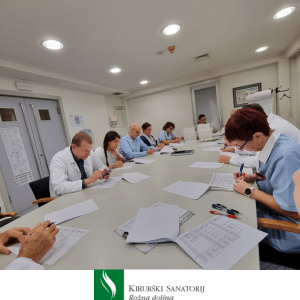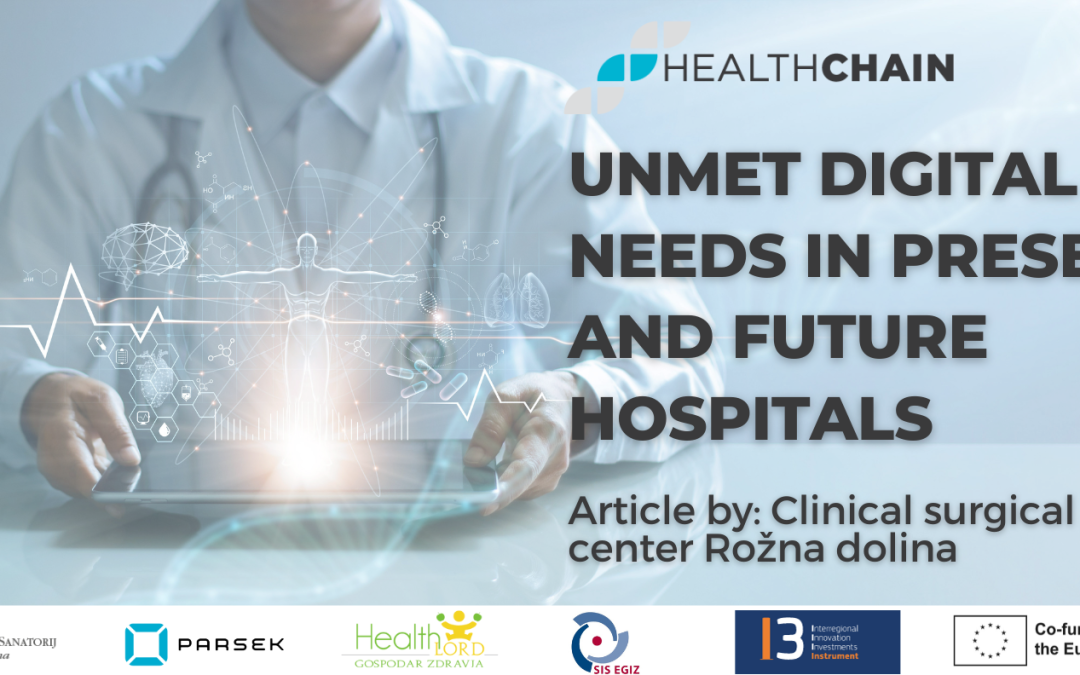UNMET DIGITAL NEEDS IN PRESENT AND FUTURE HOSPITALS
Clinical surgical center Rožna dolina
At present, there are too many digital solutions at hospitals that are based on so called legacy IT systems and are able to follow rapid development in the field of contemporary and future IT solutions only with big difficulties. Legacy systems are costly to maintain, lack scalability, and may not support modern healthcare needs, such as data analytics and mobile access.
Therefore, in hospitals, there are several unmet digital challenges that can impact the quality of patient care and the efficiency of healthcare operations. Some of them are interoperability issues. Many present hospitals still struggle with interoperability challenges, having difficulties to seamlessly share patient data among different healthcare systems, departments, and providers. This can lead to fragmented care and errors in treatment. Health information exchange facilitates the secure exchange of patient information between different healthcare organisations, but many regions still face challenges in establishing and maintaining effective health information exchange networks.

Some hospitals still continue to use outdated electronic health records systems that lack user-friendly interfaces and advanced features. These systems may not fully support clinical decision-making and can be cumbersome for healthcare professionals. Data breaches and cybersecurity threats are very significant concern in healthcare. Hospitals often lack robust cybersecurity measures to protect patient data, leaving sensitive information vulnerable to theft and ransomware attacks.
Limited telemedicine integration while the COVID-19 pandemic accelerated the adoption of telemedicine, many hospitals still face challenges in fully integrating tele-health services into their workflows. This includes issues with reimbursement, licensing, and technology infrastructure. Inefficient communication among healthcare providers, staff, and patients (based on legacy IT) can be inefficient. Hospitals need better communication platforms and tools to facilitate real-time information sharing and collaboration.

Patient engagement – present hospitals often struggle to engage patients in their care. Digital tools for patient education, remote monitoring, and communication are underutilised, leading to missed opportunities for improving outcomes. Clinical decision support – many hospitals lack robust clinical decision support systems that can provide healthcare professionals with real-time guidance and evidence-based recommendations for diagnosis and treatment. Analytics and predictive tools – while some hospitals use data analytics, there is room for improvement in the use of predictive analytics to forecast patient admissions, optimise resource allocation, and improve care delivery.
Patient data access – patients often have limited access to their own health data, and it may not be presented in a user-friendly format. Empowering patients with easy access to their medical records and health information is a crucial unmet need. Staff training and digital Literacy: Hospital staff may not receive adequate training on the use of digital tools and technologies, which can hinder their ability to leverage these tools effectively.

Clinical surgical center Rožna dolina organised two workshops (connected with the HealthChain project) with employees to discuss unmet present and future digital solutions in healthcare. Discussion was based on serious shortcomings of present digital solutions in hospital. Employees were asked to present their ideas how to improve or implement digital environment. More than forty unmet needs were exposed and the results will be available after thorough analysis.
ABOUT HEALTHCHAIN I3 PROJECT
The project offers a model for co-created, demand-driven technological solutions in health care by creating optimal value-chains. It provides a framework in which innovations do not arise from technological vacuum and therefore have a short lifespan. From the very start it includes all stakeholders within health care ecosystem, based on their active participation. Optimizing applicability of innovation for end users, connecting European Mirror regions and IT/digital solution companies this project ensures that all the parties are benefiting, with the aim to create user-friendly and timely access to health care, while taking into account investments, organizational and tendering process optimization. It directs future innovations to the point where investments are maximally utilized and ready for further commercialization. Furthermore, it aims to create a sustainable community of practice in EU regions which will sustain value-chain model on the long term.
HealthChain model will be implemented and validated in 5 regions. Each region brings together the same structure of roles:

A. Healthcare Organisation (HO) with the role of Challenge identifier that proposes the needs and pilots the proposed solutions in their premises.
B. Two IT companies (or Solvers) with mature IT/digital technology.
C. Regional Ecosystem Supporter (ES) e.g., a business association or cluster, that delivers business support and leads the connection between cross-border regions.
OUR REGION, WESTERN SLOVENIA:
Within the HealthChain project in Our region – Western Slovenia – Surgical Centre Rožna dolina challenge will be related to Hip arthrosis management, which has a big burden on patients’ quality of life, functional independence, and disability. The digital health companies working together with HO to develop solutions are Gospodar zdravja/Healthlord and Parsek and with the help of SIH EEIG – Slovenian Innovation Hub delivering high-quality business support.
